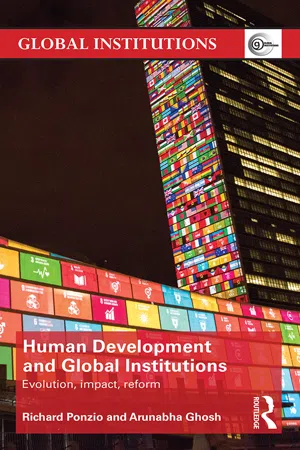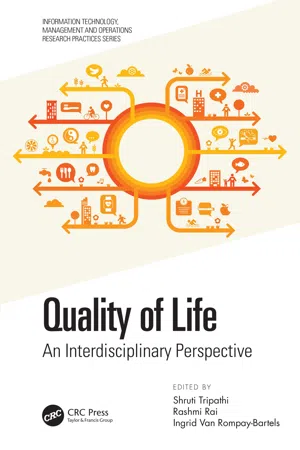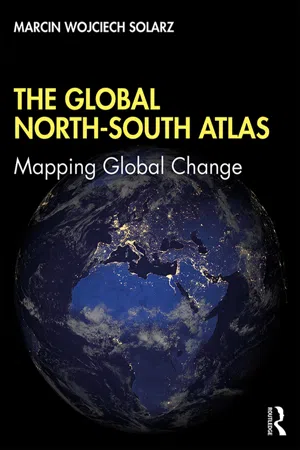Indicators of Human Development
Indicators of human development are measures used to assess the well-being and quality of life of a population. These indicators include factors such as life expectancy, education levels, income, and access to basic amenities. They are used to compare the development levels of different countries and to track progress over time.
6 Key excerpts on "Indicators of Human Development"
- eBook - ePub
Human Development and Global Institutions
Evolution, Impact, Reform
- Richard Ponzio, Arunabha Ghosh(Authors)
- 2016(Publication Date)
- Routledge(Publisher)
...Meanwhile the HDI and other human development composite measures also have aided international policy-makers, development practitioners, and scholars in assessing the estimated aggregate progress of the world, specific regions, and within sub-national units. This includes the application of innovative measurement methodologies to the comparison of neighborhoods within large municipalities in the Global North and South, including New York City and Rio de Janeiro. Urban-rural differentiation within countries has also aided decision-makers in understanding better the extent to which and why certain parts of a country or sub-region are being left behind despite human development progress within a national or sub-national political unit. Shedding light on domestic group distinctions Fourth, indices are disaggregated to shed light on differences between specific kinds of groups in a particular polity. In addition to the geography, each human development composite indicator can also be disaggregated along other lines, including male/female, age group, income level, and ethnic group. In doing so, they further advance thinking and assessments of the rich and multifaceted concept of human development among government and donor policy-makers. Moreover, these types of disaggregation have proven instrumental in helping decision-makers determine priorities and formulate human-development-related policies and reforms that aim to bridge the kinds of inequality gaps that if left unchecked may continue to fester and grow, and can prove politically de-stabilizing and engender deadly violence and material destruction. 33 Informing development policy debates Fifth and finally, these indices have informed debates on future global development priorities. Beginning in the early to mid-1990s, the data collected, assembled in composite indicators, and analyzed had an immediate impact in informing and shaping global development priorities agreed at a string of UN world conferences...
- Eckhard Siggel(Author)
- 2016(Publication Date)
- Routledge(Publisher)
...Economic development can therefore also be described as a process of growth and structural change, where the latter may refer to changes in the sector composition or to other structural effects. High average income, even if distributed in a socially acceptable way, is not a guarantee for the fulfilment of human needs in areas such as education, health care, longevity, or personal freedom. It has therefore become standard practice to define economic development by reference to sets of indicators measuring these aspects. The Human Development Index, computed and published annually since 1990 by the UNDP, is a composite indicator of several welfare aspects including education, health, and per person income. It is the subject of the first case study, where it is explained in some detail. The concept of national income as measured in the national accounts is not a perfect measure of material well-being, nor of the level of production, because it fails to include various forms of income that are either not marketed or unrecorded, such as the value of housework, child raising and various activities associated with subsistence agriculture and the informal sector. The level of subsistence and informal sector activities is usually estimated by national statistics bureaus and added on to the national accounts, but many other activities, in particular female work in the household, are not included in the concepts of domestic production and income. This is a shortcoming from the point of view of trying to measure all economic activity, but it is widely accepted because of the difficulty of measuring other activities. In spite of these limitations, the average or per capita level of income is often used as a broad indicator of the level of development. The reason for this usage is threefold: data availability, relative comparability of this measure across countries, and a strong correlation with other indicators of well-being...
- eBook - ePub
Quality of Life
An Interdisciplinary Perspective
- Shruti Tripathi, Rashmi Rai, Ingrid Van Rompay-Bartels(Authors)
- 2021(Publication Date)
- CRC Press(Publisher)
...We recommend that future research on the HDI (1) clarifies the dynamics between quality of life and standard of living, (2) explores the integration of human flourishing into the HDI and (3) includes the consideration of ecological and sustainability development factors. In addition, a conceptual model illustrating an outcome-based process approach to achieve quality of life is developed to guide the research direction for the HDI. To conclude, quality of life is an evolving concept which changes in nature with the development stages of nations, and the circumstance and context at a point in time. The HDI is a relevant indicator of quality of life at the initial development stages of a nation as it manages to uplift society above the minimum floor of achievement in human development, thereby reducing extreme human deprivation, but from a predominantly economic perspective (UNDP 2019). However, beyond the reduction of extreme human deprivation, inequalities remain and would always exist. New-generation inequalities are also arising due to phenomena such as climate change, the technological divide due to technological transformations, quality education divide, capability divide, social divide and power divide. These inequalities have an impact on ongoing human development even in the developed world. While limitations for the research in this chapter are potentially contributed by the selection of the time period within which various kinds of literature were selected for review and the types of keywords used to query the databases, the research produces a recognition that the HDI requires review and reconfiguration. Adaptation with a changing world to resolve rising inequalities, as well as the promotion of social inclusivity and sustainable development, are the tenets for a reinvented HDI. References Anand, S. and Sen, A. 2000. “The income component of the human development index.” Journal of Human Development 1(1): 83–106. Baumeister, R.F. and Leary, M.R. 1997...
- eBook - ePub
Economics and History
Surveys in Cliometrics
- David Greasley, Les Oxley, David Greasley, Les Oxley(Authors)
- 2011(Publication Date)
- Wiley-Blackwell(Publisher)
...10). In other words, human development emphasizes positive freedom (Desai, 1991, p. 356). As a synthetic measure of human development, the UNHDI tries to capture a country’s achievements in longevity, knowledge and standard of living through various indices: the relative achievement in life expectancy at birth, in education and in ‘all dimensions of human development not reflected in a long and healthy life and in knowledge’ for which the adjusted per capita GDP (its logarithm) is a surrogate (UNDP, 2001, p. 240). These achievements provide individuals the freedom to choose (Kakwani, 1993; Fleurbaey, 2009) and, thus, the opportunity ‘to lead lives they have reasons to value’ (Sen, 1997). Indices for each dimension (I) are computed according to the following formula, (1) where x is the observed value of a given dimension of welfare, and Mo and M represent the maximum and minimum values, or goalposts. Goalposts representing levels not reached yet and below the present’s lowest level, respectively, were chosen for each indicator in order to make possible comparisons over time. 4 Each dimension ranges, thus, between 0 and 1. The UNHDI is obtained as the unweighted arithmetic average of the three dimension indices. Reactions to non-conventional indicators of well-being have always been critical. One of the most popular synthetic indices, Morris’s (1979) physical quality of life index (PIQL; an unweighted average of normalized indices of infant mortality, life expectancy and literacy) was seriously questioned on the basis of the high collinearity between its first two components (Hopkins, 1991) and has only made an uncritical comeback in the historical literature (Federico and Toniolo, 1991; Domínguez and Guijarro, 2000). 5 The UNHDI, presumably an improvement on Morris’s PIQL, has been seriously questioned (Dasgupta, 1993, p. 77). 6 Srinivassan (1994, p...
- J. Edward Taylor, Travis J. Lybbert(Authors)
- 2020(Publication Date)
- University of California Press(Publisher)
...He felt this was necessary in order “to shift the focus of development economics from national income accounting to people-centered policies.” 1 The measure Haq proposed had to be simple to understand, and it had to encompass both economics and human well-being. Above all, it had to be an index, which would make it possible to compare improvements in well-being across countries. Amartya Sen provided the conceptual framework for this project. Actually, Sen initially opposed the idea, worrying that it would be too difficult to capture the full complexity of human development in a single index. In the end, Haq swayed Sen by persuading him that only a holistic development index could shift policy makers’ and researchers’ attention from economics to human well-being. Only a concept that confronts GDP head-to-head, as a single number, could get real traction in the policy process. That is how the Human Development Index (HDI) was born. After considerable discussion and debate, the UNDP decided on an index that included the following economic and human outcomes: • Life expectancy at birth (years; LE); because it is measured at birth, this index is affected by high infant mortality rates in some countries. • Education, composed of two separate measures: expected years of schooling for children (EYSC) and mean years of schooling for adults (MYSA). By having a separate measure for expected education of children, this index can reflect improvements in low-education countries that invest in expanding educational opportunities for kids. Mean years of schooling for adults would reflect such improvements only after many years have elapsed. • Income (GNI), measured as the gross national income per capita, PPP adjusted to take into account cost of living differences among countries. Table 6.1 shows the highest and lowest outcomes for each of these variables across the globe in 2013. It reveals massive disparities in human development indicators...
- eBook - ePub
The Global North-South Atlas
Mapping Global Change
- Marcin Wojciech Solarz(Author)
- 2019(Publication Date)
- Routledge(Publisher)
...The series related to the evolution of human development level encompasses all the countries in the world in the period 1980–2017 (five maps). HDI levels are marked with color and areas of circles correspond to the population(s) of the given country(ies) (in the case of previous series, GDP per capita and GDP respectively). This additionally allows quality of life to be examined not only through the prism of states but also in societies. This series is the shortest, as the history of HDI only dates back to 1990, and historical analyses of human development have only been conducted over a limited time period. It should be emphasized that an accurate reading of the maps in this chapter requires a thorough reading of both the legend (the four series of maps for GDP and GDP per capita have a common legend (Figure 1.1), as do the maps in the HDI series (Figure 1.57); the exception being maps for 2017, which have their own legends (Figures 1.54 and 1.62), and a separate introductory map that has been inserted into each series (with the exception of human development maps showing data for all the countries of the world) to illustrate the way(s) in which the data were geographically aggregated, i.e. to depict the regions described by the data (Figures 1.3, 1.20, 1.35, 1.46). FIGURE 1.1 A common legend for all series of maps showing GDP and GDP per capita (1 ad –2008) Source : Own elaboration Any attempt to show world development over the past 2000 years is fraught with risk. During this time, a great many polities have risen and fallen and political boundaries have changed radically. Moreover, the essence and understanding of development have changed. The more distant the past, the fewer the hard figures, and the more uncertain, questionable, and debatable the estimates and hypotheses...





